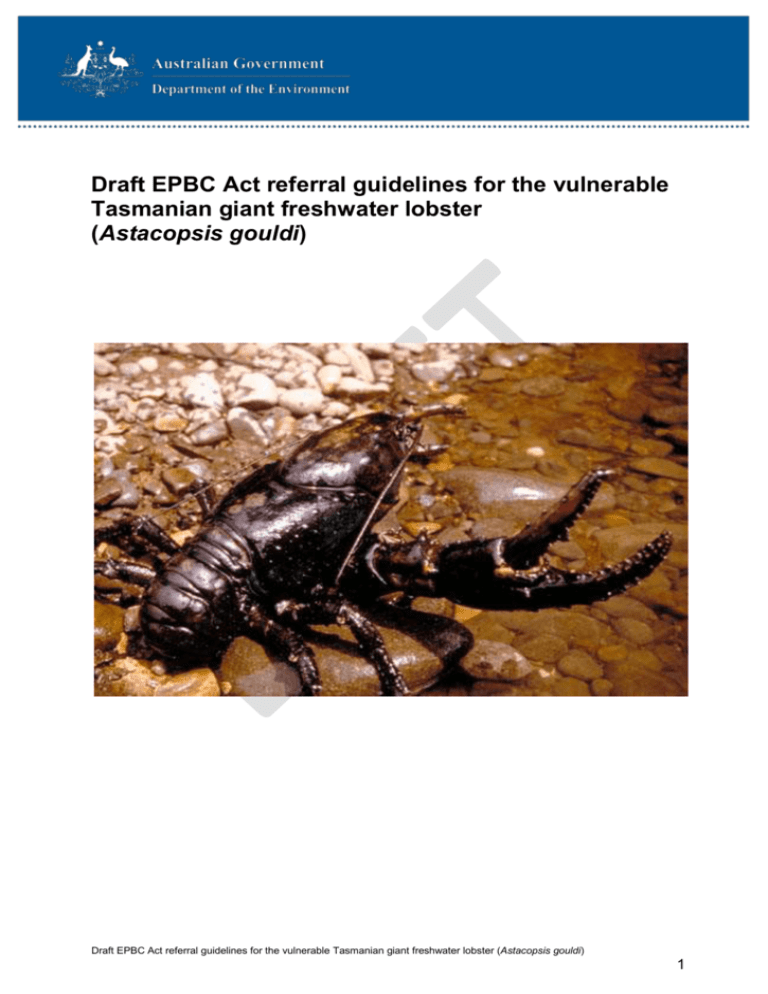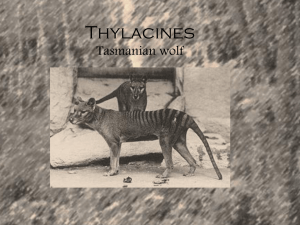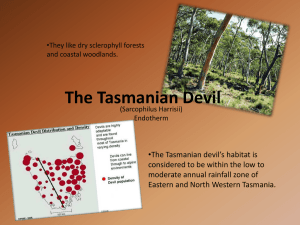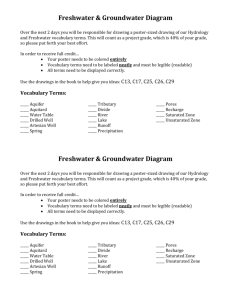
Draft EPBC Act referral guidelines for the vulnerable
Tasmanian giant freshwater lobster
(Astacopsis gouldi)
Draft EPBC Act referral guidelines for the vulnerable Tasmanian giant freshwater lobster (Astacopsis gouldi)
1
Acknowledgements
The Department of the Environment would like to thank the following people for their
valued expert advice in the development of these guidelines and their participation at
the workshop in Devonport, Tasmania, in 2010: Phil Bell, Stuart Chilcott, Niall Doran,
Clare Hawkins, Alastair Richardson and Todd Walsh.
© Commonwealth of Australia 2015
This work is copyright. You may download, display, print and reproduce this material in
unaltered form only (retaining this notice) for your personal, non-commercial use or use
within your organisation. Apart from any use as permitted under the Copyright Act
1968, all other rights are reserved. Requests and enquiries concerning reproduction
and rights should be addressed to Department of the Environment, Public Affairs, GPO
Box 787 Canberra ACT 2601 or email public.affairs@environment.gov.au.
Disclaimer
The views and opinions expressed in this publication are those of the authors and do
not necessarily reflect those of the Australian Government or the Minister for the
Environment.
While reasonable efforts have been made to ensure that the contents of this
publication are factually correct, the Commonwealth does not accept responsibility for
the accuracy or completeness of the contents, and shall not be liable for any loss or
damage that may be occasioned directly or indirectly through the use of, or reliance on,
the contents of this publication.
Image credits
Photograph of a Tasmanian giant freshwater lobster by © Laurie Goldsworthy.
Draft EPBC Act referral guidelines for the vulnerable Tasmanian giant freshwater lobster (Astacopsis gouldi)
2
Important notice
Please note that these guidelines are general in nature. They do not remove your
obligation to consider whether you need to make a referral to the Minister for the
Environment (the Minister) under the Environment Protection and Biodiversity
Conservation Act 1999 (EPBC Act). While these guidelines provide information to help
you decide whether to refer your action, the possible impacts of your proposal will
depend on the particular circumstances of the action. These circumstances may
include issues such as the proximity of the action to habitat, indirect impacts and
impact-mitigation measures.
These guidelines were developed on the basis of the best information available at the
time of writing. However, impacts of proposals will be assessed by the Australian
Government Department of the Environment (the Department) on the basis of the best
information available at that point in time, which may differ from the information on
which these guidelines are based.
These guidelines do not provide guidance on requirements under state and local
government laws. Information on Tasmanian state and local government laws can be
obtained from the Tasmanian Department of Primary Industries, Parks, Water and
Environment (DPIPWE) (www.dpipwe.tas.gov.au) and the local councils in or near the
proposed project area.
How to use these guidelines
These guidelines are intended to assist you in determining whether your action needs
to be referred to the Department. These guidelines should be read in conjunction with
Significant Impact Guidelines 1.1 – Matters of National Environmental Significance,
which can be found on the Department’s website at
www.environment.gov.au/epbc/publications/nes-guidelines.html.
These guidelines apply to the Tasmanian giant freshwater lobster (Astacopsis gouldi)
anywhere it may occur in Australia. The Tasmanian giant freshwater lobster is listed as
a vulnerable species under the EPBC Act. Listed threatened species and ecological
communities are matters of national environmental significance under the EPBC Act.
If you plan to undertake an action that has, will have or is likely to have a significant
impact on the Tasmanian giant freshwater lobster, you must refer the proposal to the
Minister before commencing. The Minister will then decide within 20 business days
whether assessment is required under the EPBC Act. The potential significance of
each action is judged on a case-by-case basis. Substantial penalties apply for
undertaking an action, to which the EPBC Act applies, without approval (civil penalties
up to $8.5 million or criminal penalties including up to seven years imprisonment).
More information on referral, assessment and compliance is available on the
Department’s website at www.environment.gov.au/epbc/.
A national recovery plan for the Tasmanian giant freshwater lobster is currently in place
and is available on the Department’s website at
www.environment.gov.au/biodiversity/threatened/publications/a-gouldi.html. The
Minister must not make a decision which is inconsistent with a national recovery plan.
The decision tree in Figure 1 and the rest of these guidelines are designed to assist
you in determining whether your proposed action needs to be referred. You may also
Draft EPBC Act referral guidelines for the vulnerable Tasmanian giant freshwater lobster (Astacopsis gouldi)
3
refer your proposed action if you are uncertain about the need to refer or contact the
Department by emailing epbc.referrals@environment.gov.au.
Possible exceptions to the need to refer
Certain actions are exempt from the requirement of assessment and approval under
the EPBC Act. These include lawful continuations of land use that started before
16 July 2000, or actions that were legally authorised before 16 July 2000. There are a
number of criteria that must be satisfied to rely on any such exemptions. More
information on exemptions under the EPBC Act is available on the Department’s
website at www.environment.gov.au/epbc/publications/exemptions.html.
Part 3 of the EPBC Act – “Environmental Approvals” – does not apply to forestry
operations undertaken in a Regional Forest Agreement (RFA) Region, where an RFA
is in place, unless the operation is being undertaken in a property on the World
Heritage List, in a Ramsar wetland or is incidental to another action whose primary
purpose does not relate to forestry. There are clauses within RFAs regarding
continuous improvement in threatened flora and fauna management, taking recovery
plans into account and establishing a comprehensive, adequate and representative
(CAR) reserve system that are intended to meet the objectives of the EPBC Act.
Persons carrying out forestry operations outside of an RFA region must consider their
obligations under the EPBC Act.
Where to get more information
The Species Profile and Threats (SPRAT) database profile for the Tasmanian giant
freshwater lobster provides the biological and ecological context for survey guidelines,
significant impact guidance and mitigation measures. The database can be accessed
on the Department’s website at www.environment.gov.au/cgi-bin/sprat/public/sprat.pl.
Other EPBC Act policy statements are available to help you understand the EPBC Act
and your obligations. They are available on the Department’s website at
www.environment.gov.au/epbc/guidelines-policies.html or by contacting the community
information unit by email: ciu@environment.gov.au or by phone: 1800 803 772. The
Department can provide assistance in ensuring your action complies with the
EPBC Act, especially when contacted early in the planning process.
The Protected Matters Search Tool, which is available on the Department’s website at
www.environment.gov.au/epbc/pmst/index.html, can provide a good starting point for
determining the likelihood of matters of national environmental significance occurring in
your area. State and territory government agencies may also hold relevant information
including habitat and species distribution information.
Draft EPBC Act referral guidelines for the vulnerable Tasmanian giant freshwater lobster (Astacopsis gouldi)
4
Figure 1: Decision making
Could the impacts of your action occur within the modelled
distribution of the Tasmanian giant freshwater lobster (see Section 2)?
NO
REFERRAL MAY NOT BE REQUIRED*
Low risk of resulting in significant
impact**
NO
REFERRAL MAY NOT BE REQUIRED*
Low risk of resulting in significant
impact**
NO
REFERRAL MAY NOT BE REQUIRED*
Low risk of resulting in significant
impact**
NO
REFERRAL RECOMMENDED
High risk of resulting in significant
impact**
YES or UNSURE
Could the impacts of your action affect any Tasmanian giant freshwater
lobster habitat (see Section 3) or individuals?
YES or UNSURE
Have you surveyed for the Tasmanian giant freshwater lobster using
the recommended methods (see Section 4)?
NO
Assume your project may have an impact on an
important population of the Tasmanian giant freshwater
lobster (see Section 5) or the species in its entirety
(Section 6).
YES
Could your action have an impact on an important
population of the Tasmanian giant freshwater lobster
(see Section 5) or the species in its entirety (Section 6)?
YES or UNSURE
Have you reviewed the impact-mitigation options (Section 7) and applied
to your project as appropriate? Prioritise impact avoidance over impact
minimisation.
YES
Could your action require a referral to the Minister for significant impacts on the Tasmanian giant freshwater lobster?
High risk that your action will result in a
significant impact on the Tasmanian
giant freshwater lobster (see Section 8)**
REFERRAL RECOMMENDED
Uncertainty as to whether your action will
result in a significant impact on the
Tasmanian giant freshwater lobster (see
Section 8)*
REFERRAL RECOMMENDED
OR CONTACT THE DEPARTMENT
Low risk that your action will result in a
significant impact on the Tasmanian
giant freshwater lobster (see Section 8)**
REFERRAL MAY NOT BE REQUIRED*
* Although it may appear that there is a low risk of a significant impact, and that a referral may not be required, you may still
choose to refer your proposed action. If you are uncertain about the need to refer then you can contact the Department to
discuss your action by emailing epbc.referrals@environment.gov.au.
** Risk is the chance rate of something happening that will have a [significant] impact on objectives [e.g. protecting matters of
national environmental significance] (adapted from Australian/New Zealand Risk Management Standard ISO 31000:2009).
Draft EPBC Act referral guidelines for the vulnerable Tasmanian giant freshwater lobster (Astacopsis gouldi)
5
1. What is known about the Tasmanian giant freshwater lobster?
The Tasmanian giant freshwater lobster, also known as the ‘tayatea’, is the largest
freshwater crayfish in the world. There are historic reports of specimens with weights
up to 6 kg, but generally animals of 2–3 kg are considered large. The Tasmanian giant
freshwater lobster is slow-growing. Females take approximately 14 years to reach
sexual maturity, which is recognised in specimens with a carapace length of 120 mm or
more. Females are believed to spawn only every second year in autumn, and carry the
eggs and recently-hatched young under their tail until the following autumn. Larger
females produce more young.
The Tasmanian giant freshwater lobster feeds mainly on decaying wood and
associated microbes. The species’ diet becomes more variable with age as it is known
to eat leaves and animal flesh (such as small fish) when available. While adults have
been known to range over several hundred metres of stream, individuals tend to spend
most of their time at their preferred sites and return to those sites whenever they
periodically move away. The species is, therefore, slow to colonise new areas.
Relevant background information on the biology and ecology of the Tasmanian giant
freshwater lobster is provided in the Department’s SPRAT database www.environment.gov.au/cgi-bin/sprat/public/publicspecies.pl?taxon_id=64415.
2. Could the impacts of your action1 occur within the modelled
distribution of the Tasmanian giant freshwater lobster?
The Tasmanian giant freshwater lobster is endemic to rivers of northern Tasmania (see
Map 1). It is known to occur in the Arthur River catchment in the north-west of the
island and all of the major river catchments that flow into Bass Strait from the Welcome
River to the Ringarooma River, with the exception of the Tamar River catchment. The
species is found at altitudes no higher than 400 m above sea level (asl), with most
caught below 200 m asl.
Localised extinctions, or large declines in numbers, of the Tasmanian giant freshwater
lobster are thought to have occurred in the Welcome, Montagu, Rubicon, Don, Brid,
Boobyalla, Pipers, Ringarooma, Duck, Little and Great Forester Rivers and Claytons
Rivulet since European settlement in Tasmania. As a result, the species’ distribution is
thought to have become more disjunct.
The Tasmanian giant freshwater lobster has been introduced into two catchments: the
North Esk catchment (St Patricks River) and the Derwent catchment (Clyde River),
although the populations in these catchments are considered to be experimental and
not ecologically functional.
The distribution maps in this document are based on the best available information at
the time of publication and remain a static product. For the most up-to-date report of
whether the Tasmanian giant freshwater lobster may occur in your project area, always
use the Department’s Protected Matter Search Tool.
1
When considering whether or not your action will have a significant impact on the Tasmanian giant
freshwater lobster, it is relevant to consider all adverse impacts from the action, including direct,
indirect and offsite impacts such as downstream or downwind impacts, upstream impacts and
facilitated impacts (impacts that result from further actions, which are made possible or facilitated by
the action).
Draft EPBC Act referral guidelines for the vulnerable Tasmanian giant freshwater lobster (Astacopsis gouldi)
6
Map 1: Modelled distribution of the Tasmanian freshwater lobster (Astacopsis gouldi)
Draft EPBC Act referral guidelines for the vulnerable Tasmanian giant freshwater lobster (Astacopsis gouldi)
7
3. Could the impacts of your action affect habitat for the Tasmanian
giant freshwater lobster?
According to the national recovery plan for the Tasmanian giant freshwater lobster,
habitat critical to the survival of the species is any habitat which has a boulder or
cobble substrate2 and water temperatures ranging from approximately 5–18 °C3. Such
habitats occur in flowing or still waters in any size of stream within the species’
modelled distribution and are usually well shaded by native riparian vegetation.
Adults are typically found in still deep pools sheltering beneath undercut banks or
snags (decaying logs), at least partly submerged in the water. They are also known to
move through shallow riffle zones.
Juveniles inhabit the abovementioned environments and are also found in smaller
tributaries and shallow fast-flowing streams. They favour habitats with large stable
rocks or logs which are not embedded in finer substrates but which occur on coarser
substrates and/or with a distinct cavity underneath.
In addition to the attributes of habitat critical to the survival of the species described in
the recovery plan, the following aquatic conditions are considered within the
Tasmanian giant freshwater lobster’s normal tolerance range and are characteristic of
its habitat:
minimum dissolved oxygen concentrations of 6 ppm or 80% saturation4
pH ranging from 4.5 to 8, and
concentrations of chemical contaminants within minimum safe levels (trigger
values) as indicated in the Australian and New Zealand guidelines for fresh and
marine water quality: Volume 1 (2000) (ANZECC guidelines) which is available
on the Department’s website at www.environment.gov.au/resource/australianand-new-zealand-guidelines-fresh-and-marine-water-quality-volume-1guidelines.
Further information on the habitat types in which the Tasmanian giant freshwater
lobster occurs is provided in the SPRAT database.
2
Substrates are defined as follows: boulder, greater than 200 mm in length, and cobble, 60–200 mm in
length.
3
The Tasmanian giant freshwater lobster prefers water temperatures at the lower end of this range.
Webb (2001) found the species occupying streams with water temperatures up to 21 °C, however
research by Hamr (1990a) and Lynch and Blühdorn (1997) found the species in streams in which
maximum water temperatures did not exceed 18 °C. Forteath (1987) found that adult specimens were
not tolerant of water temperatures exceeding 18 °C for several weeks. The Tasmanian Crayfish
Workshop estimated that the species’ minimum and maximum tolerance thresholds for water
temperature in their aquatic habitats to be 4 ºC and 22 ºC respectively.
4
100% saturation or concentrations of 9–12 ppm of dissolved oxygen in surface freshwater
environments are generally considered optimal for healthy populations or aquatic fauna. Based on the
ANZECC 2000 guidelines and the State of the Environment Report 2009 (Tasmania), the minimum
threshold for dissolved oxygen in freshwater streams in Tasmania is approximately 6 ppm or 80−90%
saturation (determined under low-flow conditions over at least one 24-hour period). The Tasmanian
Crayfish Workshop estimated that the species’ tolerance threshold for low dissolved oxygen in their
aquatic habitats to be 4 ppm.
Draft EPBC Act referral guidelines for the vulnerable Tasmanian giant freshwater lobster (Astacopsis gouldi)
8
4. Have you surveyed for the Tasmanian giant freshwater lobster
using the recommended methods?
A guide to conducting surveys for the Tasmanian giant freshwater lobster in areas of
suitable habitat is outlined below. Surveys should:
be conducted by a suitably qualified person with demonstrated skill in freshwater
crayfish surveys
maximise the chance of detecting the species, and
account for uncertainty and error (e.g. false absences).
The following survey methods are recommended to detect the Tasmanian giant
freshwater lobster. Where it is not possible to conduct surveys in this manner, or to use
equivalent, alternative methods, failure to detect the species should not be considered
indicative of its absence.
Desktop survey
A search of the relevant literature and Commonwealth and state databases and maps
will provide an indication of where the species or habitat critical to its survival may
occur in relation to an area to be affected by a proposed action. Determine whether
field surveys or habitat assessments are necessary based on the adequacy of the data
gathered during the desktop survey. Note that, where the available information
required to determine the likelihood of an action having a significant impact on the
species is inadequate, additional information may be requested by the Department.
This would result in a delay and extension of the 20-day referral decision timeframe.
Field survey
If it is determined that field surveys are required due to data deficiency, or if legal
certainty is required, surveys can be conducted year-round. However, smaller
individuals (less than 1 kg) are generally sampled more accurately in summer and
larger individuals more accurately in winter.
Different survey methods are used for juveniles and larger crayfish (sub-adults and
adults). Visual surveys are recommended for juvenile crayfish and trapping methods
for sub-adults and adults. Generally, surveys should consist of a combination of
trapping and visual surveys to reduce the risk of a false absence being recorded.
If the population structure (demographics) needs to be determined, three separate
surveys at least three weeks apart are required. The optimal timing is to conduct the
three surveys across three seasons (for example, summer, autumn and winter).
Visual search – juvenile crayfish
Visual searches are conducted by turning rocks in riffle zones and boulder/cobble
areas, with a hand-net held downstream. The effort required can be determined by
search area (minimum 250 m stretch of stream) or time (minimum four hours of
survey). All rocks in the riffle/rocky substrate zone should be turned and then slowly
returned to their original position, being careful not to crush any organisms which may
be underneath. Note that juveniles are difficult to detect or catch in smaller tributaries.
Draft EPBC Act referral guidelines for the vulnerable Tasmanian giant freshwater lobster (Astacopsis gouldi)
9
Trapping – non-juvenile crayfish
Traps, ring nets and bait lines can be used (measures should be taken to avoid the
capture or entanglement of platypus when using traps). Set six traps for a period of
four hours over a half-kilometre stretch of river. Within this search area, traps should be
placed in the most suitable habitat (deep pools, near large woody debris and
overhangs).
Care should be taken to minimise the disturbance of habitats during surveys for the
Tasmanian giant freshwater lobster. The species can suffer from shock when water
temperatures decrease about 10 °C as a result of cold weather changes so avoid
trapping during or after such weather events. Permits are needed to conduct surveys
for the species. Contact the Tasmanian Department of Primary Industries, Parks,
Water and Environment (www.dpipwe.tas.gov.au) and the Inland Fisheries Service
(www.ifs.tas.gov.au) for further information and permits.
5. Could your action have an impact on an important population of
the Tasmanian giant freshwater lobster?
Important populations are necessary for a species’ long-term survival and recovery
because they support and maintain breeding, dispersal and genetic diversity across the
species’ distribution. Therefore, important populations are an essential consideration
when assessing impacts on a vulnerable species.
A population of the Tasmanian giant freshwater lobster is an ‘important population’ if it
is:
a key source population for breeding or dispersal within a river system or
catchment
necessary for maintaining genetic diversity, or
near the limit of the species’ range.
All Tasmanian giant freshwater lobster populations occurring in habitats critical to the
survival of the species are considered to be important populations. The national
recovery plan for the Tasmanian giant freshwater lobster identifies locations (rivers and
catchments) in which important populations occur.
6. Could your action have an impact on the species in any other way?
In addition to having an impact on important populations of the Tasmanian giant
freshwater lobster, you might have an impact on the species in its entirety. In contrast,
you might not have an impact on an important population but you may have an impact
on the species by other means. For example, an impact on the species may result by
facilitating the spread of disease, or invasive or predatory species, or by destroying or
modifying unoccupied but optimal habitat which may be critical to the long-term survival
of the species. Any action which may directly or indirectly result in any of these sorts of
effects is likely to have a significant impact on the species.
For further information on significant impact criteria, refer to page 11 of Significant
Impact Guidelines 1.1. Section 8 of this document provides some further guidance on
how the significant impact criteria may be applicable to the impacts of your proposed
action.
Draft EPBC Act referral guidelines for the vulnerable Tasmanian giant freshwater lobster (Astacopsis gouldi)
10
7. Is your impact mitigation best practice so that it may reduce the
significance of your impacts?
When designing your proposed action, avoiding impacts on the Tasmanian giant
freshwater lobster should be your principal aim. This can be achieved by retaining
habitat and preserving populations of the Tasmanian giant freshwater lobster. If you
believe that options to retain habitat and preserve populations are not possible, then
you should mitigate any remaining impacts.
Table 1 outlines the main threats to the Tasmanian giant freshwater lobster, the
associated impacts and measures to reduce the level of impacts. It is not intended to
be exhaustive or prescriptive.
Impact-mitigation should be monitored to ensure that it is effective and to allow for
adaptive management responses.
The Department sometimes considers a translocation of a listed threatened species in
relation to an action referred for assessment and approval under the EPBC Act,
primarily when it is proposed to be on a temporary basis. Refer to the Department’s
policy statement on the translocation of listed threatened species, which is available on
the Department’s website at www.environment.gov.au/resource/epbc-act-policystatement-translocation-listed-threatened-species-assessment-under-chapter.
Draft EPBC Act referral guidelines for the vulnerable Tasmanian giant freshwater lobster (Astacopsis gouldi)
11
Table 1: Primary threats, impacts and mitigation
Threat
Impact
Mitigation
Reduced water
Reduced habitat suitability due to altered
quality
sediment levels, oxygen levels, temperature and
(through actions such
pH of the water
as the removal of
Mortality due to pesticides and other chemicals
riparian vegetation,
channel alterations,
bridge constructions or
upgrades, releases
from water storages or
pesticide applications)
Establish or maintain a buffer of at least 30 m of natural vegetation along the length of streams known to
support Tasmanian giant freshwater lobster populations.
Use effective erosion controls and sediment traps to prevent siltation of habitat.
Release water from large dams in a manner that minimises thermal pollution or deoxygenation of the
aquatic environment (for example, multi-level takeoff and remixing).
Maintain water quality to the ANZECC guidelines (www.environment.gov.au/resource/australian-and-newzealand-guidelines-fresh-and-marine-water-quality-volume-1-guidelines).
Avoid aerial spraying near watercourses. All aerial spraying should follow the DPIPWE Code of Practice
for aerial spraying June 2000 (http://dpipwe.tas.gov.au/agriculture/agvet-chemicals/codes-of-practiceguidelines-and-information-sheets/codes-of-practice/code-of-practice-for-aerial-spraying).
Follow Forestry Tasmania’s Keeping It Clean field hygiene manual.
Habitat degradation
(through actions such
as the removal of instream woody debris or
the crossing of streams
by livestock or with
machinery)
Loss of in-stream habitat such as woody debris
Loss of breeding habitat (riffles)
Loss of boulder/cobble habitat which protects
juveniles from predation
Loss of riparian vegetation
Where feasible, re-align in-stream debris rather than removing from the stream.
Follow the Tasmanian DPIPWE willow management guidelines (dpipwe.tas.gov.au/invasivespecies/weeds/weeds-index/weeds-index-declared-weeds/willows) when removing willows from streams.
Avoid stock access to streams and stream banks. Fence new agricultural land from stream banks Provide
off-stream stock watering points.
Avoid machinery crossings in boulder/cobble riffles. Where necessary, place machinery crossings in
areas of streams where the substrate is predominantly pebbly2.
Follow the Forest Practices Code [Forest Practices Board (2000), Tasmania] for stream crossings
(www.fpa.tas.gov.au/__data/assets/pdf_file/0020/58115/Forest_Practices_Code_2000.pdf).
Water extraction or
changes to flows
Loss of habitat
Direct mortality of individuals
Maintain the existing hydrology of the local catchment area.
Set and provide for minimum environmental flows.
Fragmentation
Reduced ability to recolonise areas
(barriers to movement
and dispersal including Reduced gene flow between populations
altered water velocity)
Avoid the use of pipe culverts where possible. Where required, use appropriate culvert and stream
crossing design to allow movement (for example, inverted U design with substrate equivalent to, and level
with, the adjacent streambed).
Incorporate measures on weirs to facilitate the passage of lobsters.
Illegal fishing and
invasive species
Use access restrictions to limit the risk of illegal fishing.
Discourage and report illegal fishing.
Implement quarantine protocols where appropriate to reduce the risk of introducing exotic species.
Direct mortality of individuals
Predation and competition from introduced
aquatic species such as the common yabby
(Cherax destructor) and redfin perch (Perca
fluviatilis)
Draft EPBC Act referral guidelines for the vulnerable Tasmanian giant freshwater lobster (Astacopsis gouldi)
12
8. Could your action require a referral to the Minister for significant
impacts on the Tasmanian giant freshwater lobster?
It is your responsibility to decide whether or not to refer your action to the Minister. If
you believe your action is likely to have a significant impact on the Tasmanian giant
freshwater lobster, you must refer. If you are uncertain whether your action will have
a significant impact on the Tasmanian giant freshwater lobster, you may still refer for
legal certainty or contact the Department. Table 2 provides guidance on what may be
at high to low risk of requiring a referral to the Department, and where uncertainty
may exist. This guidance is not intended to be comprehensive. Other types of actions
or impacts may constitute varying degrees of risk.
Table 1: Referral guidelines
High risk of significant impacts on the Tasmanian giant freshwater lobster:
referral recommended
Actions in habitats where important populations occur that may result in:
a measurable and statistically-significant addition of sediment (silt and small gravel) to
the aquatic habitat over the long-term (one year or more) relative to up-stream “control”
values
the alteration of water temperature to or outside the extremes of 4 ºC and 22 ºC
dissolved oxygen in water being lower than 4 ppm
an alteration of the pH outside the range of 4.5–8
the loss of minimum water flows through the habitat
chemical concentrations in the water in the habitat in water outside of ANZECC water
quality guidelines
any permanent barrier to in-stream movement of individuals (includes changes to water
velocity that impede in-stream movement)
the removal of the main trunk of in-stream woody debris
the removal of embedded debris
the removal of vegetation within 30 m of a stream bank.
Uncertainty: referral recommended or contact the Department
Actions in habitats where important populations occur that may result in:
a measurable and statistically-significant addition of sediment (silt and small gravel) for
a short term (less than one year) relative to up-stream “control” values
the alteration of water temperature outside the normal seasonal variation (5–18 ºC)
dissolved oxygen in water being lower than 6 ppm
the increased chance of the introduction or establishment of predatory or competitive
species
the introduction of captive-bred individuals, which may be vectors for disease, into wild
populations
a temporary displacement of individuals from their habitat (e.g. a translocation of
lobsters during a bridge construction or upgrade).
Draft EPBC Act referral guidelines for the vulnerable Tasmanian giant freshwater lobster (Astacopsis gouldi)
13
Low risk of significant impacts on the Tasmanian giant freshwater lobster:
referral may not be required but you may refer for legal certainty
Actions that will not directly or indirectly affect Tasmanian giant freshwater lobster
important populations, suitable habitat or the species as a whole
Actions that occur outside the modelled distribution of the Tasmanian giant freshwater
lobster
Draft EPBC Act referral guidelines for the vulnerable Tasmanian giant freshwater lobster (Astacopsis gouldi)
14







